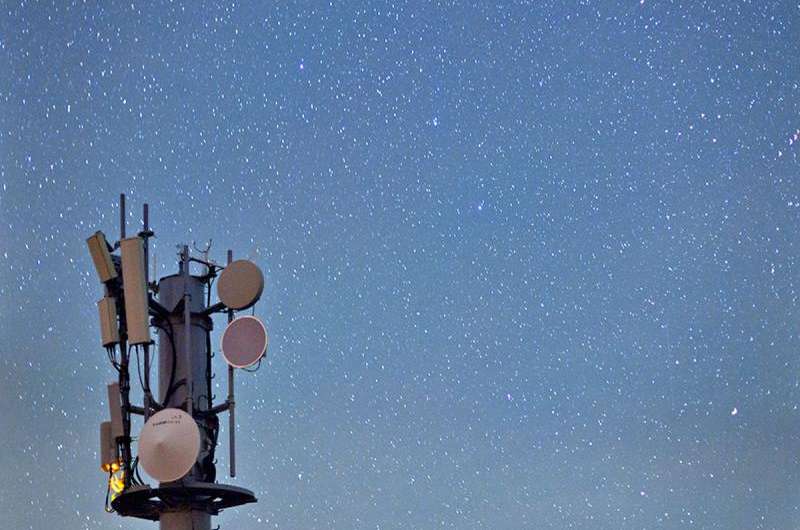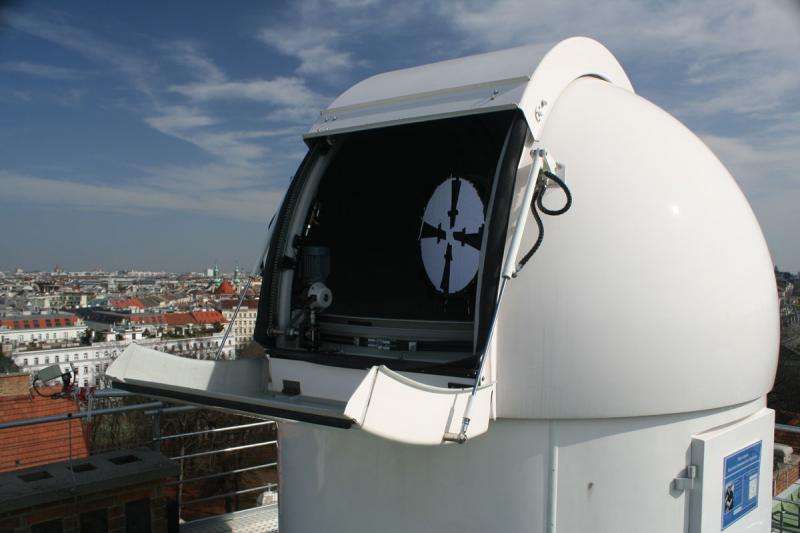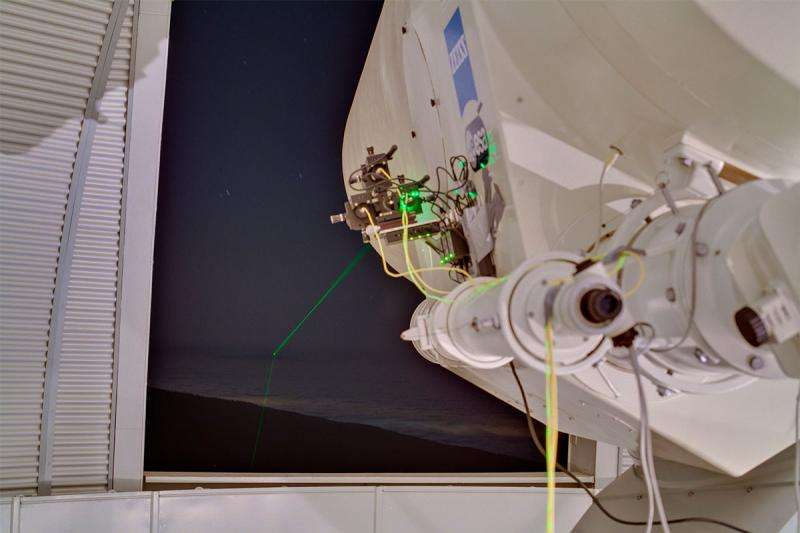November 6, 2015 report
Researchers take two big steps toward quantum computing

(Phys.org)—"Spooky action at a distance," Einstein's famous, dismissive characterization of quantum entanglement, has long been established as a physical phenomenon, and researchers are keen to develop practical applications for entanglement including communication, encryption, and computing.
Quantum entanglement is a phenomenon in which the production or the interactions of a number of particles cannot be described independently of each other, and must instead be described in terms of the whole system's quantum state.
Two recent experiments with entanglement have been reported in the Proceedings of the National Academy of Sciences, one proving that complex quantum states in photons can be preserved even in turbulent atmospheric conditions; the other demonstrating entanglement swapping between qubits over the 143 kilometers between the Canary Islands and Tenerife.
In the first experiment, a group of Austrian researchers sought to transmit complex, quantum-encoded information through turbulent air. The polarization of photons is a robust technique favored for long-distance entanglement research in which two photons with mutually perpendicular polarizations exist in different locations. The state is easily controllable and resistant to atmospheric turbulence. But polarization is a binary state that cannot easily carry complex information. The encoding of more complex information in an entangled system—for instance, a jpeg image of Albert Einstein shaking his fist at entangled photons–would require a much larger space state than the two-dimensional space state of polarization.

The researchers used photons with a twisted phase front, which carry an unbounded amount of orbital angular momentum (OAM)—a much larger space state than polarization. In principle, OAM offers the possibility of practical applications like quantum encryption and the testing of fundamental properties of quantum physics. But OAM is quite sensitive to atmospheric turbulence. However, the researchers succeeded in distributing the quantum entanglement of spatially structured photons over a free-space link across the city of Vienna.
In the experiment, the sender, traditionally known in quantum entanglement experiments as Alice, and the receiver, Bob, were in different physical locations three kilometers apart. Alice was in a 35-meter-high radar tower with a high-fidelity, high-brightness entanglement source that produced entangled pairs. Photon A remained unchanged, while photon B's polarization state was transferred interferometrically to a generated hybrid-entangled quantum OAM state.
Photon A was delayed via a 30 meter fiber cable to ensure that it was not measured before photon B was transferred to Bob, on the other side of the city. After the transfer, the polarization of photon A was measured and each detection event time-stamped. Similarly, the detection of photon B was time-stamped and the two events were correlated at a sub-nanosecond regime. The researchers verified quantum entanglement of the pairs through turbulent atmosphere. Though they were still using a two-dimensional space state, the method allows for a quantum link with up to 11 orthogonal channels of OAM.
They write, "Our result clearly shows that entanglement encoded in OAM can be identified after long-distance transmission. It is not fundamentally limited by atmospheric turbulence, as expected in some recent investigation, and thus could be a feasible way to distribute high-dimensional entanglement."

In the second experiment, another group that included many of the same researchers teleported an entangled state between two qubits, a process known as entanglement swapping. This is in contrast to the teleportation of a single quantum state from one qubit to another; in essence, the researchers created an entangled state between two qubits located 143 kilometers from each other, and which had never interacted before.
This provides a solution to the no-cloning theorem, which in quantum theory states that it is impossible to create an identical copy of an unidentified quantum state. By demonstrating the applicability of the technique outside the laboratory, the experiment opens a door to such practical applications as cloud quantum computing.
The researchers don't shy from the significance of this accomplishment, writing, "Our data demonstrate successful entanglement swapping via a long-distance free-space link under the influence of highly demanding environmental conditions, in fact more challenging than expected for a satellite-to-ground link. This proves the feasibility of a crucial element for realizing a quantum repeater in a future space- and ground-based worldwide quantum internet."
More information: Paper 1: Twisted photon entanglement through turbulent air across Vienna. PNAS 2015 ; published ahead of print November 2, 2015, DOI: 10.1073/pnas.1517574112
Abstract
Photons with a twisted phase front can carry a discrete, in principle, unbounded amount of orbital angular momentum (OAM). The large state space allows for complex types of entanglement, interesting both for quantum communication and for fundamental tests of quantum theory. However, the distribution of such entangled states over large distances was thought to be infeasible due to influence of atmospheric turbulence, indicating a serious limitation on their usefulness. Here we show that it is possible to distribute quantum entanglement encoded in OAM over a turbulent intracity link of 3 km. We confirm quantum entanglement of the first two higher-order levels (with OAM=± 1ℏ and ± 2ℏ). They correspond to four additional quantum channels orthogonal to all that have been used in long-distance quantum experiments so far. Therefore, a promising application would be quantum communication with a large alphabet. We also demonstrate that our link allows access to up to 11 quantum channels of OAM. The restrictive factors toward higher numbers are technical limitations that can be circumvented with readily available technologies.
Paper 2: Teleportation of entanglement over 143 km. PNAS 2015 ; published ahead of print November 2, 2015, DOI: 10.1073/pnas.1517007112
Abstract
As a direct consequence of the no-cloning theorem, the deterministic amplification as in classical communication is impossible for unknown quantum states. This calls for more advanced techniques in a future global quantum network, e.g., for cloud quantum computing. A unique solution is the teleportation of an entangled state, i.e., entanglement swapping, representing the central resource to relay entanglement between distant nodes. Together with entanglement purification and a quantum memory it constitutes a so-called quantum repeater. Since the aforementioned building blocks have been individually demonstrated in laboratory setups only, the applicability of the required technology in real-world scenarios remained to be proven. Here we present a free-space entanglement-swapping experiment between the Canary Islands of La Palma and Tenerife, verifying the presence of quantum entanglement between two previously independent photons separated by 143 km. We obtained an expectation value for the entanglement-witness operator, more than 6 SDs beyond the classical limit. By consecutive generation of the two required photon pairs and space-like separation of the relevant measurement events, we also showed the feasibility of the swapping protocol in a long-distance scenario, where the independence of the nodes is highly demanded. Because our results already allow for efficient implementation of entanglement purification, we anticipate our research to lay the ground for a fully fledged quantum repeater over a realistic high-loss and even turbulent quantum channel.
Journal information: Proceedings of the National Academy of Sciences
© 2015 Phys.org





















